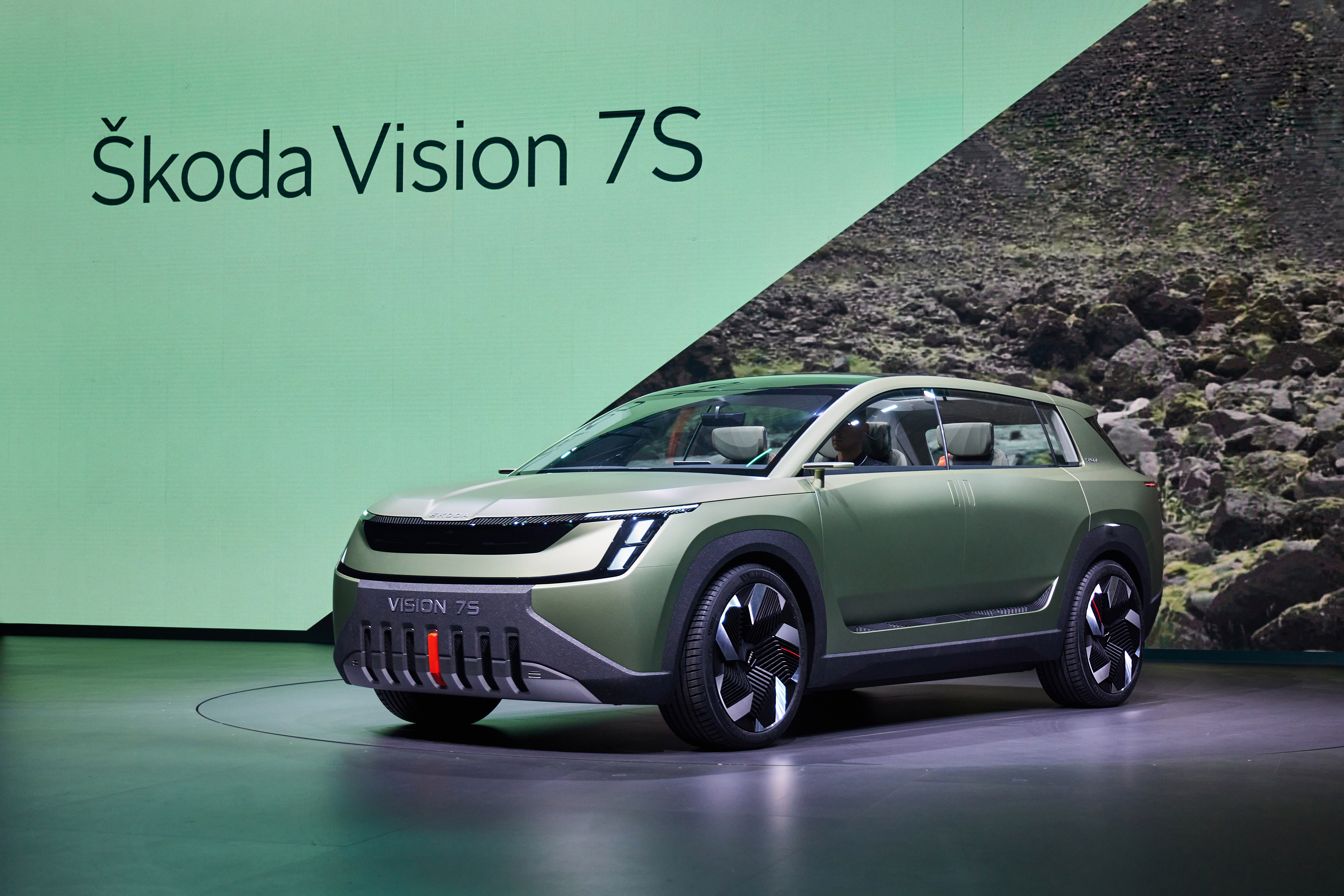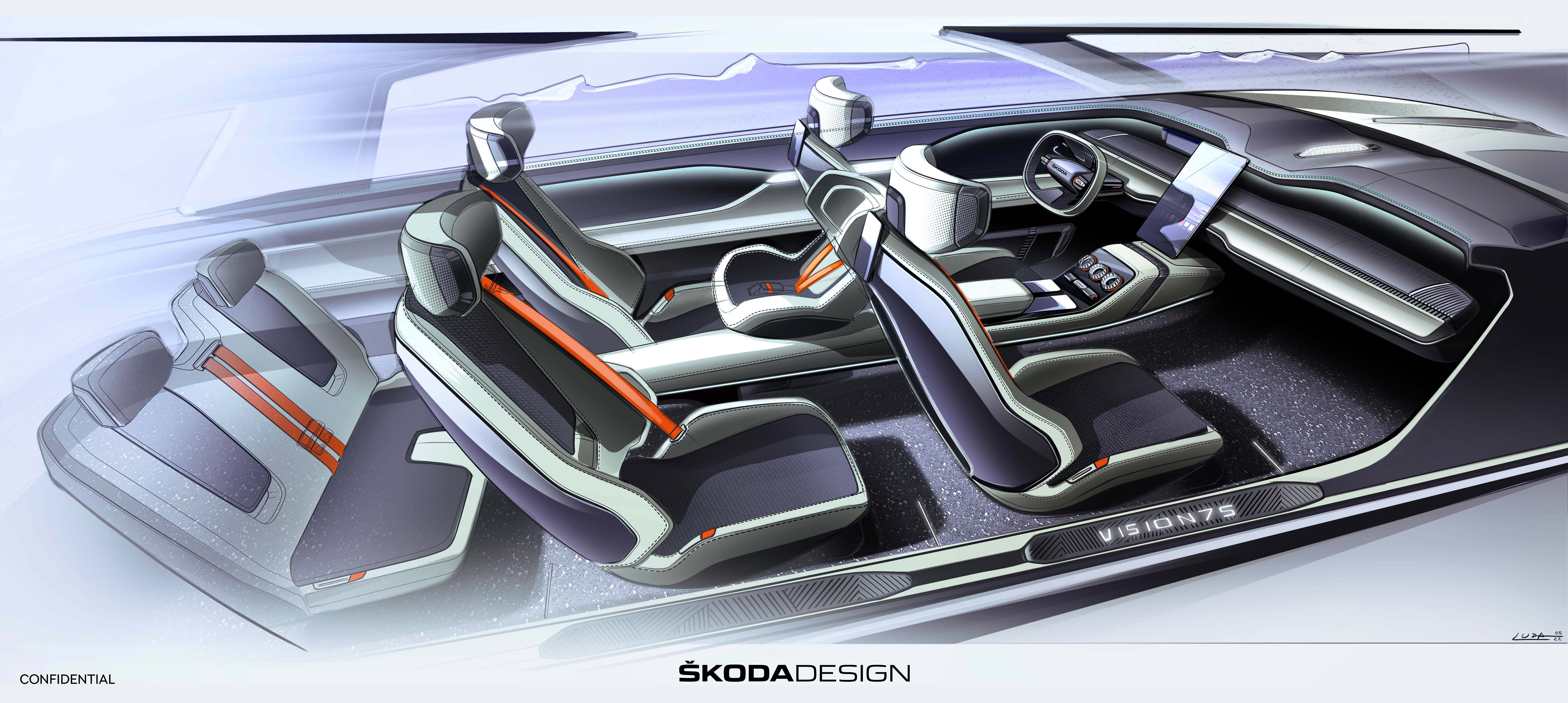We don’t need the ribs, but we need this line. So we kept it and introduced something we call Tech-Deck Face – because in the future we’ll probably have more radars, cameras and sensors that we’ll need to incorporate. And this black polycarbonate screen you can see in the front can cover all of this, and it can also grow whenever we need. So it’s a good design approach for the future that we can use. It won’t get out of fashion because it’s really changeable. And this makes it a completely new approach. We have slim daylights on the top and because we’re talking SUVs here, we have four vertical headlights – it’s the four-eye design we have today on other SUVs, but in a different way. This is also something that makes the car – and future ŠKODAs – look unique and distinctive. So we changed actually almost everything on the car, but without losing typical elements. We need people to say: I see a ŠKODA and I see development.
 Sketch of the ŠKODA VISION 7S exterior
Sketch of the ŠKODA VISION 7S exterior
Will the new design language be applied to the next generations of current models, too, or only to newly developed ones?
For now, it will be used solely on electric cars, the first one – an SUV smaller than ENYAQ iV - will come in 2024. But, of course, we’re one brand and we don’t want to separate ourselves from combustion engines. So in the future when we’ll build a car with a combustion engine, we won’t do it with the old design because it would look old. So they have to work and be linked together.
Was designing this concept – the whole process and experience – any different from working on other models like the new FABIA for example?
Yes, it was, because we had no reference. We did everything from scratch. We have great designers, young designers, talented and creative designers who made lots of sketches. Then we picked one and said: that’s the way we’ll go. Whenever we needed to decide something, we always said: no, make it more modern, more progressive. Let’s forget the old world, let’s go further and faster. And that’s something that was really very enjoyable for me. It pushed everybody to another level.
 Sketch of the VISION 7S
Sketch of the VISION 7S
How about the interior?
We’re taking a holistic and completely new approach to the interior as well. But just as with the exterior, certain ŠKODA rules will remain. The interior will stay symmetric. It will be democratic – we’re approaching the whole family, we call it the crew. The interior is really crew-oriented rather than driver-oriented. There’s a solid feeling from how we modelled the dashboard or door panels so that you really feel protected. We are also changing the way you control things, we’re not going fully tactile, we also have haptic controllers, both physical buttons and ones with a haptic response. We believe that when you drive a car, having to do everything on touch displays only is not a good way. You need at least some haptic controllers you can easily find and press with confidence you’re doing what you wanted.
Are there some details that are hidden at first sight that you’d like to point out?
The car has cladding over the wheels which serves for the aerodynamics, we can add maybe just a few kilometres of range by this, but these are details that we do care for. We do everything for customers. Another example is the third brake light which is divided because then we can have the centre section of the roof come lower and improve aerodynamics. Then we have some coloured elements on the car which are stylish on the one hand, but also give the car a very modern feeling on the other hand. We use sustainable materials in seats and many other places. There are a number of such details.
 The VISION 7S study was presented on August 30, 2022.
The VISION 7S study was presented on August 30, 2022.
What are you the proudest of regarding this concept?
That we’ve brought this to the end as it is now. (Laughs) I like the proportions of the car, I like the rear very much, I love the headlights. And in the interior I like the seats and the centre console. It’s such a strong approach rich in so many ideas that you’ll be really, really surprised.
Which parts were the toughest, what did you struggle with?
Nothing in particular. But the trickiest part of a car is always the front. It was demanding to get the spirit of ŠKODA into this part while making something completely modern at the same time.
 Sketch of the ŠKODA VISION 7S interior
Sketch of the ŠKODA VISION 7S interior
































